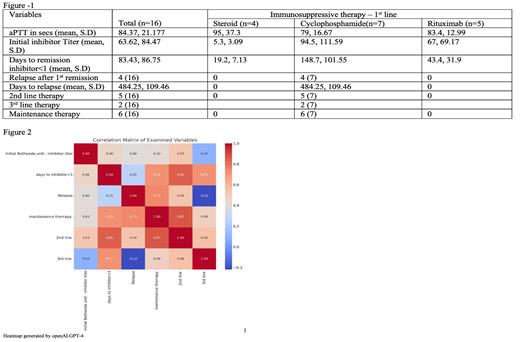Background
Acquired hemophilia A (AHA) is a rare disorder characterized by emergence of neutralizing antibodies or inhibitors to factor VIII. The main treatment strategy for AHA involves control of bleeding with factor VIII bypassing agents and eradicating the autoantibodies using immunosuppressive therapy (IST) for restoration of normal hemostasis. Previous studies have demonstrated the effectiveness of both cyclophosphamide and rituximab in combination with steroids for treating AHA, however, clear guidelines for choosing between these agents for rapid inhibitor eradication are lacking. This retrospective study aimed to compare the effectiveness of cyclophosphamide and rituximab as first-line therapies for rapid antibody elimination and relapse prevention.
Methods
We queried our hospital electronic health record system using ICD 9/10 code to identify patients >18 years that had at least 2 inpatient or outpatient encounters for the diagnosis of AHA between 1 st July 2013 and 30 th June 2023. Variables collected included initial aPTT value, serial factor VIII activity & Bethesda inhibitor titer and immunosuppressive therapies used. Time to remission was defined when inhibitor titer was <1% along with improving factor VIII activity. At our institute, all patients received 1mg/kg of steroids initially, then either six cycles of 400mg/kg IV Cyclophosphamide every 28 days on day 1 along with 100mg of oral Prednisone days 1-5 or four cycles of IV Rituximab at a weekly dose of 375mg/m2 was used as 1 stline IST for patients with inhibitor titer >10%. Patients that did not achieve remission or those with persistently high inhibitor titers after 3 cycles of Cyclophosphamide were switched to 2 nd line therapy. In few patients oral Cyclophosphamide or Mycophenolate mofetil was used as maintenance therapy after 1 st or 2 nd line therapy. Bleeding control was achieved with use of rpFVIII or rFVII, FEIBA or emicizumab depending on product availability. Descriptive statistics (mean, SD) & openAI.ChatGPT-4 generated correlation coefficient was used for data analysis.
Results
A total of 11 male and 5 female patients were identified. The mean age at diagnosis was 69 years and the average length of follow up was 672 days. The mean aPTT value at diagnosis was 84.3 seconds. Inhibitor titer ranged from 1.5 to 329% with an average of 63.62%. Patients with low inhibitor titer of <10% received only steroids and all of them achieved remission without relapse. Rituximab as first-line therapy led to remission in 100% of cases, while only 28.5% of patients treated with cyclophosphamide achieved remission without needing second-line therapy. The time to remission was significantly shorter in patients treated with rituximab compared to cyclophosphamide (43.4vs148.7days). Additionally, none of the patients treated with rituximab experienced a relapse after 1 st remission, while 57% of patients treated with cyclophosphamide did and majority needed 2 nd line & maintenance therapy (Figure-1). Initial inhibitor titer had a moderate to strong positive correlation with the time to remission, the incidence of relapse, and the need for second line and maintenance therapy (Figure- 2).
Conclusions
Rituximab as first line IST appeared to be more effective than cyclophosphamide in achieving rapid remission and reducing incidence of relapse. Our analysis also revealed that initial inhibitor titer may serve as a useful predictor of disease course, potentially guiding therapeutic decision-making and eliminating need for cytotoxic medication or maintenance therapy. Future large prospective studies are needed to confirm these findings and further investigate other factors influencing therapeutic outcomes in patients with AHA.
Disclosures
No relevant conflicts of interest to declare.


